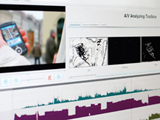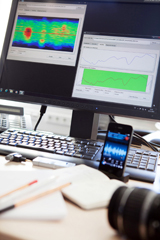New Tools for Quality Control, Identification, and forensics
Today, broadcasters, video producers, and digital archives work with huge quantities of audiovisual data. Without special tools, using, searching, and managing this content is often difficult. At this year´s IBC trade show in Amsterdam, Fraunhofer IDMT presents its large library of analyzing components that help to investigate digital picture and sound recordings fast and reliably as well as generate and analyze various types of metadata automatically.


The A/V-Analyzing Toolbox offers QC-components that allow recognizing quality problems in audio and video content. Automatically generated metadata help to split videos in several time segments and key frames (temporal video segmentation) and detect global motions such as panning, tilting, zooming or camera shake (video motion detection). Furthermore speech or music can be differentiated. With the new tool for face recognition, faces in pictures and videos will be detected and automatically related to certain persons, e.g. actors.
An additional field of application is the segment-based identification of video material. Many TV broadcasters rely on film material from agencies for their reports, and change it with fading or by altering the sequence of images and sounds. This makes it difficult to look for contributions in archives or on the Internet. Support can be provided by processes that can identify video segments that come from the same recording or source. To this end, fingerprints are extracted from the videos and compared with one another in a multi-stage automatic process. This can be used, for example, to find out which reports the same material was used and which TV channels reported on a certain topic. This makes it easier to track information regarding rights and origins, avoids unnecessary retention of duplicates, and allows the integrity of segments to be
monitored.
Processes such as this are now to be complemented with newly developed audio forensic tools that detect the use of different microphones in recordings, can locate cuts in audio material, and can detect previous coding steps and the parameters thereof. These processes can improve segment-based video identification by taking information from the audio track into account. Furthermore, the technical quality check can be expanded by, say, automatically detecting codec and bit rate of earlier coding steps and thus avoiding the use of lesser-quality material or unintentional duplicate coding. These processes can still be used to annotate steps and processing parameters automatically during production.
Due to a lack of time, editors often include incomplete or erroneous annotations, even though they are indispensable for later searching and for managing large quantities of data, such as the devices used for the recording. Most of all, however, the audio forensic tools described here can also help to check whether audio clips that are thought to be authentic, in terms of that they weren't really edited after the recording in order to subvert their meaning. This may be of great importance when using user-generated content for journalistic research, for example.
Visit us at the Fraunhofer booth B80 in hall 8. We look forward to seeing you.
Last modified:
 Fraunhofer Institute for Digital Media Technology IDMT
Fraunhofer Institute for Digital Media Technology IDMT